Exploitation of Satellite A-DInSAR Time Series for Detection, Characterization and Modelling of Land Subsidence
Abstract
:1. Introduction
- Detection of the magnitude and distribution of land subsidence;
- Characterization of the mechanisms involved in land subsidence; and
- Modelling of land subsidence due to groundwater level changes.
2. Data and Methods
- Earth-science data and information on the magnitude and distribution of land subsidence in order to recognize and to assess future problems; and
- Research on subsidence processes and engineering methods in order to prevent damage.
2.1. The Oltrepo Pavese Test Case
2.2. The Alto Guadalentín Test Case
2.3. The London Basin Test Case
3. Results
3.1. Time Series Support for Detection of Land Subsidence: The Oltrepo Pavese Test Case
3.2. Time Series Support for the Characterization of Land Subsidence Mechanisms: The Alto Guadalentín Test Case
3.3. Time Series Support for Modelling of Land Subsidence: The London Basin Test Case
4. Conclusions
Acknowledgments
Author Contributions
Conflicts of Interest
References
- Holzer, T.L.; Galloway, D.L. Impacts of land subsidence caused by withdrawal of underground fluids in the United States. Rev. Eng. Geol. 2005, 16, 87–99. [Google Scholar] [CrossRef]
- Abidin, H.Z.; Andreas, H.; Gumilar, I.; Sidiq, T.P.; Gamal, M. Environmental Impacts of Land Subsidence in Urban Areas of Indonesia. In Proceedings of the FIG Working Week 2015, TS 3—Positioning and Measurement, Sofia, Bulgaria, 17–21 May 2015. [Google Scholar]
- Syvitski, J.; Higgins, S. Going under: The world’s sinking deltas. New Sci. 2012, 216, 40–43. [Google Scholar] [CrossRef]
- Galloway, D.; Jones, D.R.; Ingebritsen, S.E. Land Subsidence in the United States; US Geological Survey: Reston, VA, USA, 1999; p. 177.
- Cigna, F.; Osmanoğlu, B.; Cabral-Cano, E.; Dixon, T.H.; Ávila-Olivera, J.A.; Gardũno-Monroy, V.H.; DeMets, C.; Wdowinski, S. Monitoring land subsidence and its induced geological hazard with Synthetic Aperture Radar Interferometry: A case study in Morelia, Mexico. Remote Sens. Environ. 2012, 117, 146–161. [Google Scholar] [CrossRef]
- Bozzano, F.; Esposito, C.; Franchi, S.; Mazzanti, P.; Perissin, D.; Rocca, A.; Romano, E. Understanding the subsidence process of a quaternary plain by combining geological and hydrogeological modelling with satellite InSAR data: The Acque Albule Plain case study. Remote Sens. Environ. 2015, 168, 219–238. [Google Scholar] [CrossRef]
- Jones, C.E.; An, K.; Blom, R.G.; Kent, J.D.; Ivins, E.R.; Bekaert, D. Anthropogenic and geologic influences on subsidence in the vicinity of New Orleans, Louisiana. J. Geophys. Res. Solid Earth 2016, 121, 3867–3887. [Google Scholar] [CrossRef]
- Herrera, G.; Fernández, J.A.; Tomás, R.; Cooksley, G.; Mulas, J. Advanced interpretation of subsidence in Murcia (SE Spain) using A-DInSAR data-modelling and validation. Nat. Hazards Earth Syst. Sci. 2009, 9, 647. [Google Scholar] [CrossRef]
- Crosetto, M.; Monserrat, O.; Cuevas-González, M.; Devanthéry, N.; Crippa, B. Persistent scatterer interferometry: A review. ISPRS J. Photogramm. Remote Sens. 2016, 115, 78–89. [Google Scholar] [CrossRef]
- Ferretti, A.; Fumagalli, A.; Novali, F.; Prati, C.; Rocca, F.; Rucci, A. A new algorithm for processing interferometric data-stacks: SqueeSAR. IEEE Trans. Geosci. Remote Sens. 2011, 49, 3460–3470. [Google Scholar] [CrossRef]
- Kampes, B.M.; Hanssen, R.F.; Perski, Z. Radar interferometry with public domain tools. In Proceedings of the FRINGE 2003 Workshop, Frascati, Italy, 1–5 December 2003. [Google Scholar]
- Arnaud, A.; Adam, N.; Hanssen, R.; Inglada, J.; Duro, J.; Closa, J.; Eineder, M. ASAR ERS Interferometric phase continuity. In Proceedings of the International Geoscience and Remote Sensing Symposium, Toulouse, France, 21–25 July 2003. [Google Scholar]
- Berardino, P.; Fornaro, G.; Lanari, R.; Sansosti, E. A new algorithm for surface deformation monitoring based on small baseline differential SAR interferograms. IEEE Trans. Geosci. Remote Sens. 2002, 40, 2375–2383. [Google Scholar] [CrossRef]
- Duro, J.; Closa, J.; Biescas, E.; Crosetto, M.; Arnaud, A. High Resolution Differential Interferometry using time series of ERS and ENVISAT SAR data. In Proceedings of the 6th Geomatic Week Conference, Barcelona, Spain, February 2005; Available online: https://pdfs.semanticscholar.org/d4bc/b3461ddb06da0704815bb40d815d780c8eb8.pdf (accessed on 10 April 2017).
- Hooper, A. A multi-temporal InSAR method incorporating both persistent scatterer and small baseline approaches. Geophys. Res. Lett. 2008, 35, L16302. [Google Scholar] [CrossRef]
- US National Research Council. Mitigating Losses from Land Subsidence in the United States; National Academy Press: Washington, DC, USA, 1991.
- González, P.J.; Fernández, J. Drought-driven transient aquifer compaction imaged using multitemporal satellite radar interferometry. Geology 2011, 39, 551–554. [Google Scholar] [CrossRef]
- Meisina, C.; Zucca, F.; Fossati, D.; Ceriani, M.; Allievi, J. Ground deformation monitoring by using the permanent scatterers technique: The example of the Oltrepo Pavese (Lombardia, Italy). Eng. Geol. 2006, 88, 240–259. [Google Scholar] [CrossRef]
- Brambilla, G. Prime considerazioni cronologico-ambientali sulle filliti del Miocene superiore di Portalbera (Pavia-Italia settentrionale). In Nuove Ricerche Archeologiche in Provincia di Pavia, Proceedings of the Convegno di Casteggio, Casteggio, Italy, 14 October 1990; Civico Museo Archeologico di Casteggio e dell’Oltrepò Pavese: Casteggio, Italy, 1992; pp. 109–113. (In Italian) [Google Scholar]
- Pellegrini, L.; Vercesi, P.L. Considerazioni morfotettoniche sulla zona a sud del Po tra Voghera (PV) e Sarmato (PC). Atti Tic. Sci. Terra 1995, 38, 95–118. (In Italian) [Google Scholar]
- Cavanna, F.; Marchetti, G.; Vercesi, P.L. Idrogeomorfologia e Insediamenti a Rischio Ambientale. Il Caso Della Pianura Dell’Oltrepò Pavese e del Relativo Margine Collinare; Ricerche & Risultati, Valorizzazione dei progetti di ricerca 1994/97; Fondazione Lombardia Ambiente; Isabel Litografia: Gessate, Italy, 1998; pp. 14–72. (In Italian) [Google Scholar]
- Pilla, G.; Sacchi, E.; Ciancetti, G. Studio idrogeologico, idrochimico ed isotopico delle acque sotterranee del settore di pianura dell’Oltrepò Pavese (Pianura lombarda meridionale). G. Geol. Appl. 2007, 5, 59–74. (In Italian) [Google Scholar]
- Boni, A.; Boni, P.; Peloso, G.F.; Gervasoni, S. Dati sulla neotettonica del foglio di Pavia (59) e di parte dei fogli voghera (71) ed alessandria (70). CNRPF Geodin. Pubbl. 1980, 356, 1199–1223. (In Italian) [Google Scholar]
- Meisina, C. Engineering geological mapping for urban areas of the Oltrepo Pavese plain (Northern Italy). In Proceedings of the 10th Congress of the International Association for Engineering Geology and the Environment (IAEG), Nottingham, UK, 6–10 September 2006. [Google Scholar]
- Meisina, C.; Zucca, F.; Notti, D.; Colombo, A.; Cucchi, A.; Savio, G.; Giannico, C.; Bianchi, M. Geological interpretation of PSInSAR data at regional scale. Sensors 2008, 8, 7469–7492. [Google Scholar] [CrossRef] [PubMed]
- Bateson, L.; Cuevas, M.; Crosetto, M.; Cigna, F.; Schijf, M.; Evans, H. PANGEO: Enabling Access to Geological Information in Support of GMES: Deliverable 3.5 Production Manual. version 1. 2012. Available online: http://nora.nerc.ac.uk/19289/ (accessed on 10 April 2017).
- Bianchini, S.; Cigna, F.; Righini, G.; Proietti, C.; Casagli, N. Landslide hotspot mapping by means of persistent scatterer interferometry. Environ. Earth Sci. 2012, 67, 1155–1172. [Google Scholar] [CrossRef]
- Lu, P.; Casagli, N.; Catani, F.; Tofani, V. Persistent Scatterers Interferometry Hotspot and Cluster Analysis (PSI-HCA) for detection of extremely slow-moving landslides. Int. J. Remote Sens. 2012, 33, 466–489. [Google Scholar] [CrossRef]
- Peduto, D.; Cascini, L.; Arena, L.; Ferlisi, S.; Fornaro, G.; Reale, D. A general framework and related procedures for multiscale analyses of DInSAR data in subsiding urban areas. ISPRS J. Photogramm. Remote Sens. 2015, 105, 186–210. [Google Scholar] [CrossRef]
- Di Martire, D.; Novellino, A.; Ramondini, M.; Calcaterra, D. A-differential synthetic aperture radar interferometry analysis of a Deep Seated Gravitational Slope Deformation occurring at Bisaccia (Italy). Sci. Total Environ. 2016, 550, 556–573. [Google Scholar] [CrossRef] [PubMed]
- Bonì, R.; Pilla, G.; Meisina, C. Methodology for Detection and Interpretation of Land subsidence Areas with the A-DInSAR Time Series Analysis. Remote Sens. 2016, 8, 686. [Google Scholar] [CrossRef]
- Bourgois, J.; Mauffret, A.; Ammar, A.; Demnati, A. Multichannel seismic data imaging of inversion tectonics of the Alboran Ridge (Western Mediterranean Sea). Geo-Mar. Lett. 1992, 12, 117–122. [Google Scholar] [CrossRef]
- Martınez-Dıaz, J.J. Stress field variation related to fault interaction in a reverse oblique-slip fault: The Alhama deMurcia fault, Betic Cordillera, Spain. Tectonophysics 2002, 356, 291–305. [Google Scholar] [CrossRef]
- Instituto Geológico y Minero de España (IGME). Mapa Geologico de España, 1:50.000, Sheet Lorca (953); Servicio de Publicaciones Ministerio de Industria: Madrid, Spain, 1981. (In Spanish)
- Cerón, J.C.; Pulido-Bosch, A. Groundwater problems resulting from CO2 pollution and overexploitation in Alto Guadalentín aquifer (Murcia, Spain). Environ. Geol. 1996, 28, 223–228. [Google Scholar]
- Confederación Hidrográfica del Segura (CHS). Plan especial ante situaciones de alerta y eventual sequia en la cuenca del Segura: Confederacion hidrografica del Segura. Technical Report. 1996. (In Spanish). Available online: https://www.chsegura.es/chs/cuenca/sequias/pes/eeapes.html (accessed on 11 April 2017).
- Martín, V.J.M.; Espinosa, G.J.S.; Pérez, R.A. Mapa geológico de España: E. 1:50,000; Servicio de Publicaciones, Ministerio de Industria y Energía, Instituto geológico y minero de España (IGME): Madrid, Spain, 1973.
- González, P.J.; Fernández, J. Error estimation in multitemporal InSAR deformation time series, with application to Lanzarote, Canary Islands. J. Geophys. Res. 2011, 116, B10404. [Google Scholar] [CrossRef]
- Bonì, R.; Herrera, G.; Meisina, C.; Notti, D.; Béjar-Pizarro, M.; Zucca, F.; González, P.J.; Palano, M.; Tomás, R.; Fernández, J.; et al. Twenty-year advanced DInSAR analysis of severe land subsidence: The Alto Guadalentín Basin (Spain) case study. Eng. Geol. 2015, 198, 40–52. [Google Scholar] [CrossRef]
- Zhang, Y.; Xue, Y.-Q.; Wu, J.-C.; Ye, S.-J.; Wei, Z.-W.; Li, Q.-F.; Yu, J. Characteristics of aquifer system deformation in the Southern Yangtse Delta, China. Eng. Geol. 2007, 90, 160–173. [Google Scholar] [CrossRef]
- Royse, K.R.; de Freitas, M.; Burgess, W.G.; Cosgrove, J.; Ghail, R.C.; Gibbard, P.; King, C.; Lawrence, U.; Mortimore, R.N.; Owen, H.G.; et al. Geology of London, UK. Proc. Geol. Assoc. 2012, 123, 22–45. [Google Scholar] [CrossRef]
- Ford, J.R.; Mathers, S.J.; Royse, K.R.; Aldiss, D.T.; Morgan, D.J.R. Geological 3D modelling: Scientific discovery and enhanced understanding of the subsurface, with examples from the UK. Z. Dtsch. Ges. Geowiss. 2010, 161, 205–218. [Google Scholar] [CrossRef]
- Mathers, S.J.; Burke, H.F.; Terrington, R.L.; Thorpe, S.; Dearden, R.A.; Williamson, J.P.; Ford, J.R. A geological model of London and the Thames Valley, southeast England. Proc. Geol. Assoc. 2014, 125, 373–382. [Google Scholar] [CrossRef]
- Ellison, R.A.; Woods, M.A.; Allen, D.J.; Forster, A.; Pharaoh, T.C.; King, C. Geology of London: Special Memoir for 1:50,000 Geological Sheets 256 (North London), 257 (Romford), 270 (South London), and 271 (Dartford) (England and Wales); British Geological Survey: Nottingham, UK, 2004.
- Sumbler, M.G. British Regional Geology: London and the Thames Valley, 4th ed.; HMSO for the British Geological Survey: London, UK, 1996. [Google Scholar]
- Jones, M.A.; Hughes, A.G.; Jackson, C.R.; Van Wonderen, J.J. Groundwater resource modelling for public water supply management in London. Geol. Soc. Lond. Spec. Publ. 2012, 364, 99–111. [Google Scholar] [CrossRef]
- Fry, V.A. Lessons from London: Regulation of open-loop ground source heat pumps in central London. Q. J. Eng. Geol. Hydrogeol. 2009, 42, 325–334. [Google Scholar] [CrossRef]
- Bloomfield, J.P.; Bricker, S.H.; Newell, A.J. Some relationships between lithology, basin form and hydrology: A case study from the Thames basin, UK. Hydrol. Process. 2011, 25, 2518–2530. [Google Scholar] [CrossRef]
- O’Shea, M.J.; Sage, R. Aquifer recharge: An operational drought-management strategy in North London. Water Environ. J. 1999, 13, 400–405. [Google Scholar] [CrossRef]
- O’Shea, M.J.; Baxter, K.M.; Charalambous, A.N. The hydrogeology of the Enfield-Haringey artificial recharge scheme, north London. Q. J. Eng. Geol. Hydrogeol. 1995, 28 (Suppl. 2), S115–S129. [Google Scholar] [CrossRef]
- Bonì, R.; Cigna, F.; Bricker, S.; Meisina, C.; McCormack, H. Characterisation of hydraulic head changes and aquifer properties in the London Basin using Persistent Scatterer Interferometry land subsidence data. J. Hydrol. 2016, 540, 835–849. [Google Scholar] [CrossRef]
- Werner, C.; Wegmüller, U.; Wiesmann, A.; Strozzi, T. Interferometric point target analysis with JERS-1 L-band SAR data. In Proceedings of the IEEE International Geoscience and Remote Sensing Symposium, IGARSS 2003, Toulouse, France, 21–25 July 2003; Volume 7, pp. 4359–4361. [Google Scholar]
- Cigna, F.; Jordan, H.; Bateson, L.; McCormack, H.; Roberts, C. Natural and anthropogenic geohazards in greater London observed from geological and ERS-1/2 and ENVISAT persistent scatterers land subsidence data: Results from the EC FP7-SPACE PanGeo Project. Pure Appl. Geophys. 2015, 172, 2965–2995. [Google Scholar] [CrossRef]
- Chaussard, E.; Bürgmann, R.; Shirzaei, M.; Fielding, E.J.; Baker, B. Predictability of hydraulic head changes and characterization of aquifer-system and fault properties from InSAR-derived ground deformation. J. Geophys. Res. Solid Earth 2014, 119, 6572–6590. [Google Scholar] [CrossRef]
- Hoffmann, J.; Galloway, D.L.; Zebker, H.A. Inverse modelling of interbed storage parameters using land subsidence observations, Antelope Valley, California. Water Resour. Res. 2003, 39. [Google Scholar] [CrossRef]
- Calderhead, A.I.; Therrien, R.; Rivera, A.; Martel, R.; Garfias, J. Simulating pumping-induced regional land subsidence with the use of InSAR and field data in the Toluca Valley, Mexico. Adv. Water Resour. 2011, 34, 83–97. [Google Scholar] [CrossRef]
- Teatini, P.; Castelletto, N.; Ferronato, M.; Gambolati, G.; Janna, C.; Cairo, E.; Marzorati, D.; Colombo, D.; Ferretti, A.; Bagliani, A.; et al. Geomechanical response to seasonal gas storage in depleted reservoirs: A case study in the Po River basin, Italy. J. Geophys. Res. Earth Surf. 2011, 116. [Google Scholar] [CrossRef]
- Hoffmann, J.; Zebker, H.A.; Galloway, D.L.; Amelung, F. Seasonal subsidence and rebound in Las Vegas Valley, Nevada, observed by Synthetic Aperture Radar Interferometry. Water Resour. Res. 2001, 37, 1551–1566. [Google Scholar] [CrossRef]
- Tomás, R.; Herrera, G.; Delgado, J.; Lopez-Sanchez, J.M.; Mallorquí, J.J.; Mulas, J. A ground subsidence study based on DInSAR data: Calibration of soil parameters and subsidence prediction in Murcia City (Spain). Eng. Geol. 2010, 111, 19–30. [Google Scholar] [CrossRef]
- Ezquerro, P.; Herrera, G.; Marchamalo, M.; Tomás, R.; Béjar-Pizarro, M.; Martínez, R. A quasi-elastic aquifer deformational behavior: Madrid aquifer case study. J. Hydrol. 2014, 519, 1192–1204. [Google Scholar] [CrossRef]
- Benedetti, L.C.; Tapponnier, P.; Gaudemer, Y.; Manighetti, I.; van der Woerd, J. Geomorphic evidence for an emergent active thrust along the edge of the Po Plain: The Broni-Stradella fault. J. Geophys. Res. Solid Earth 2003, 108. [Google Scholar] [CrossRef]
- Meisina, C. Light buildings on swelling/shrinking soils: Case histories from Oltrepo Pavese (north-western Italy). Int. Conf. Probl. Soils 2003, 2, 28–30. [Google Scholar]
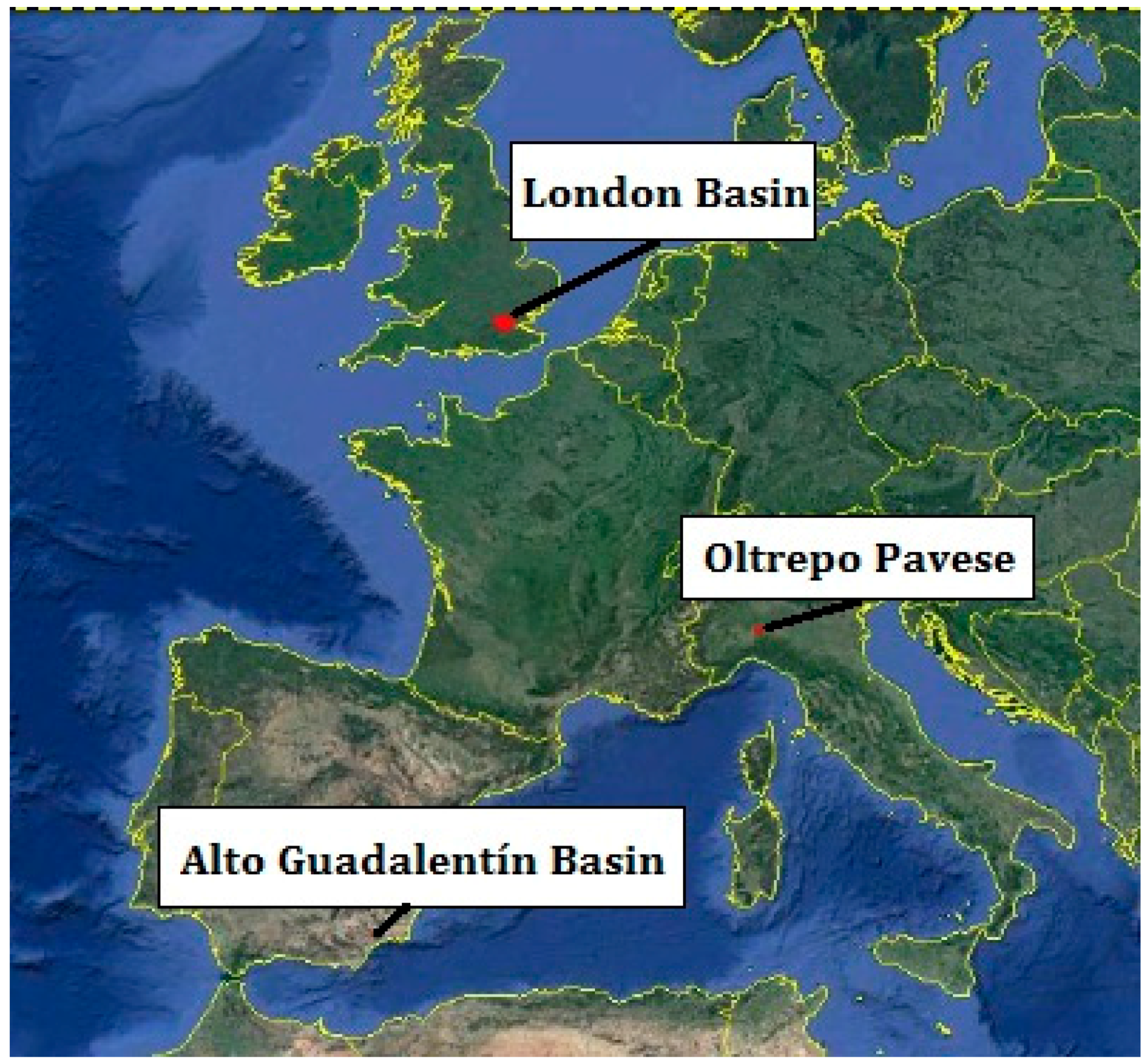
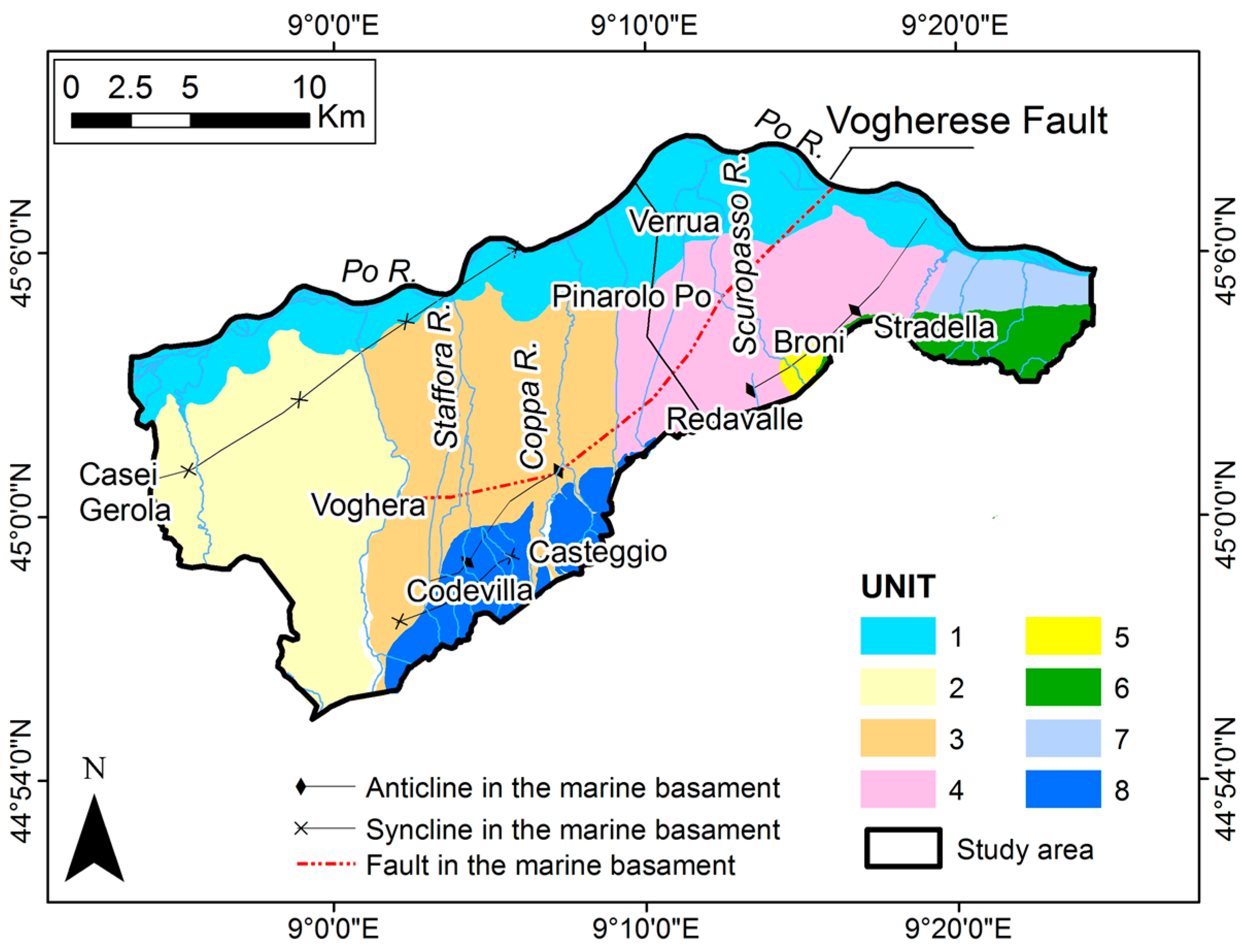
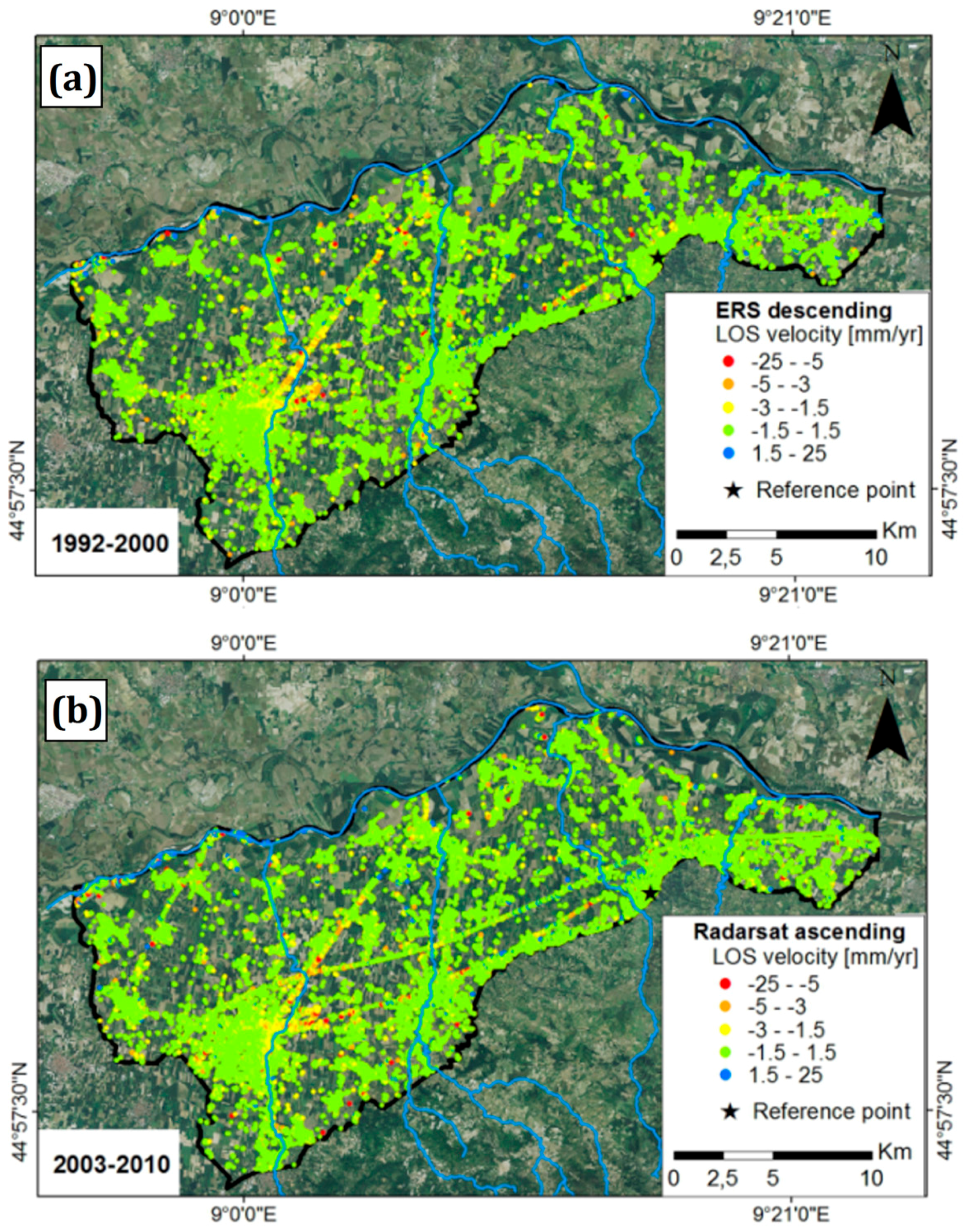
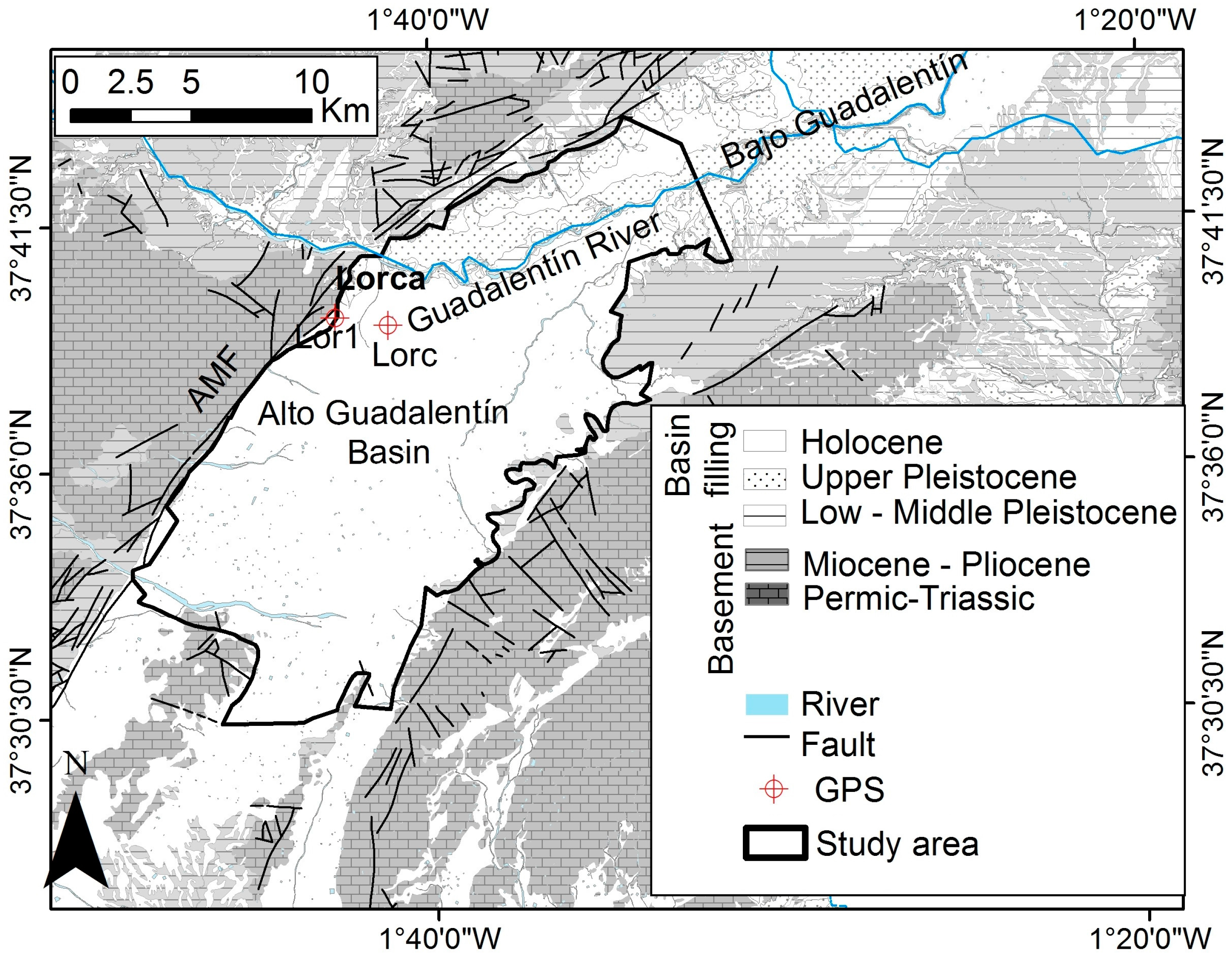

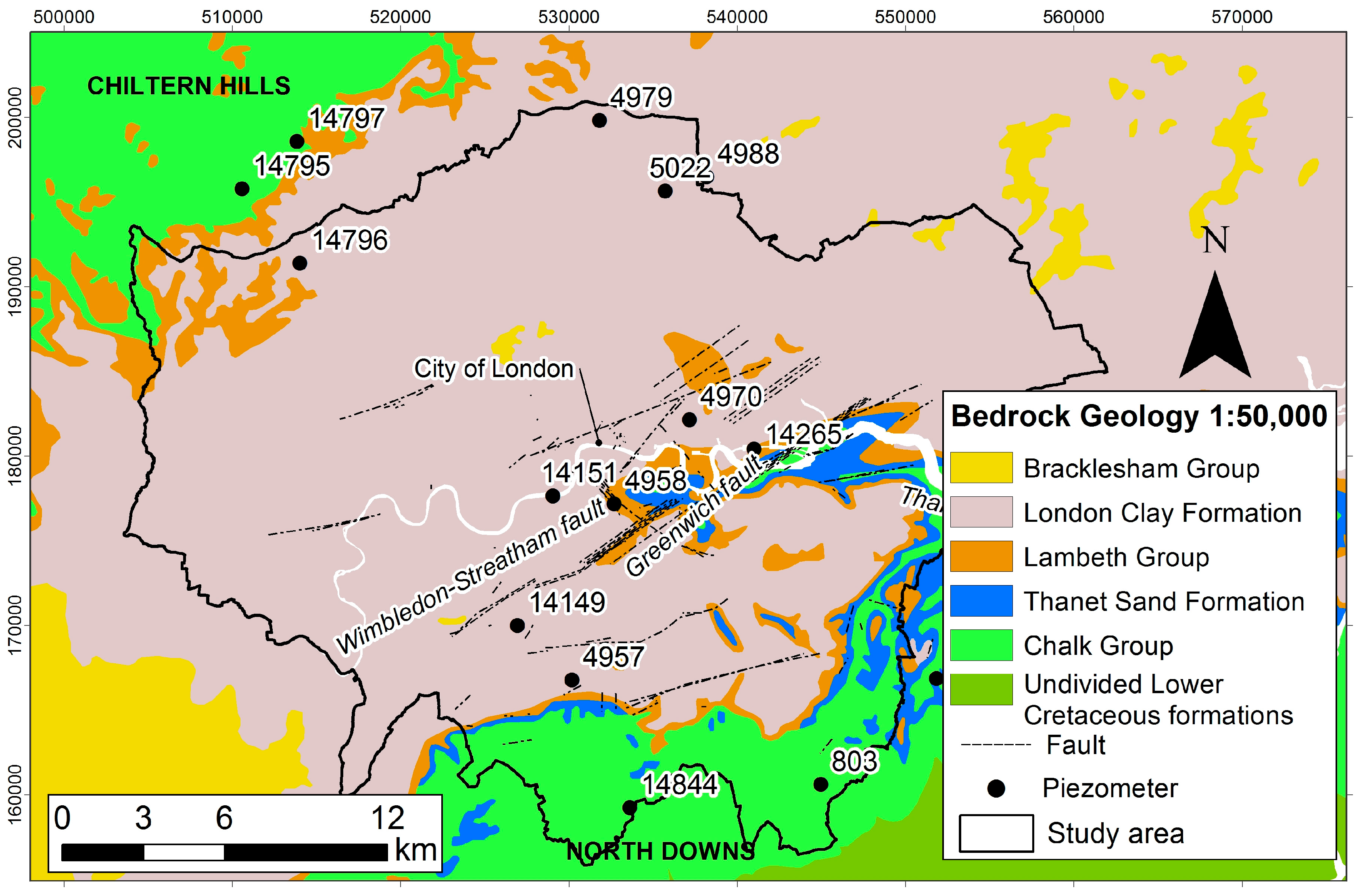

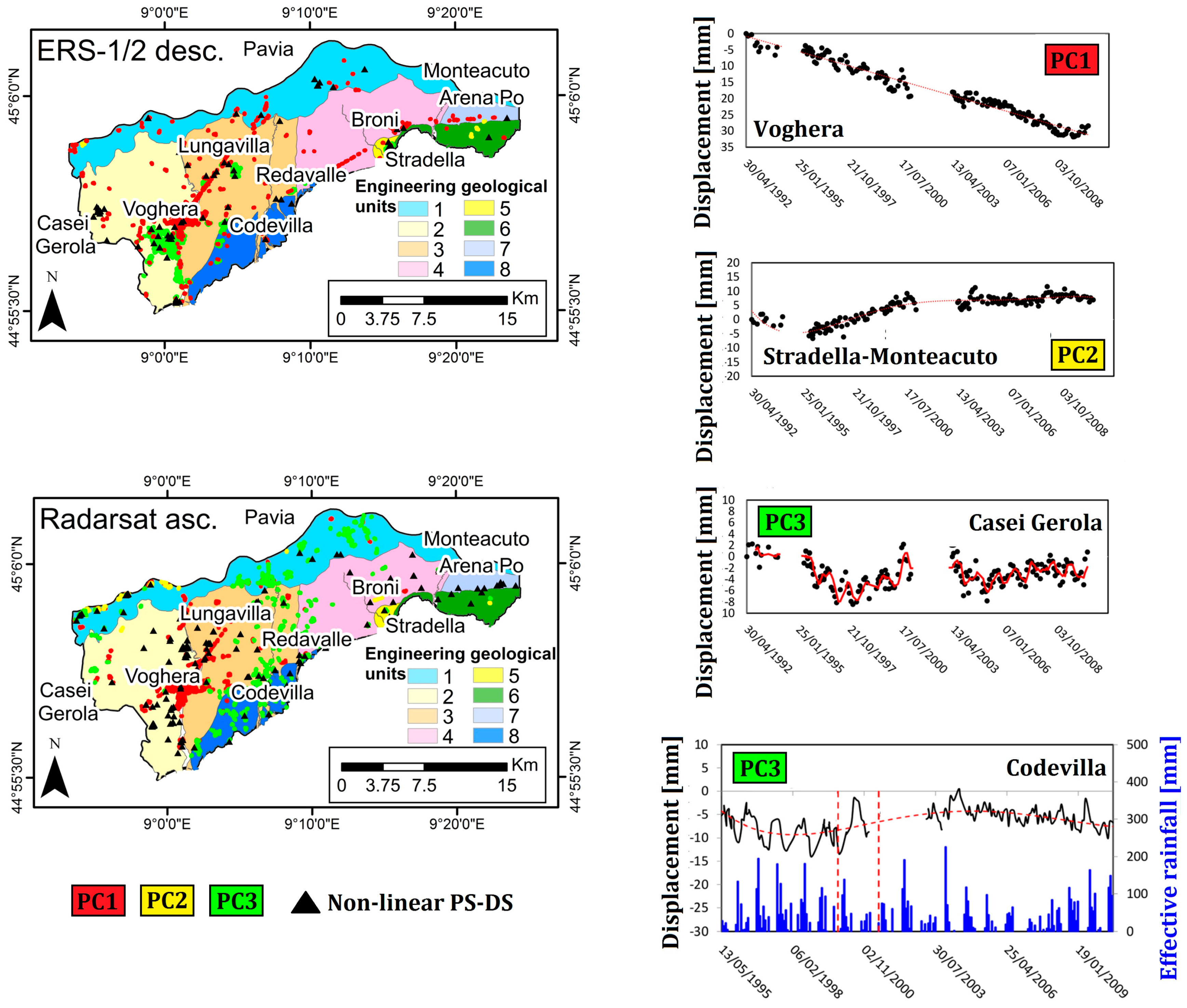



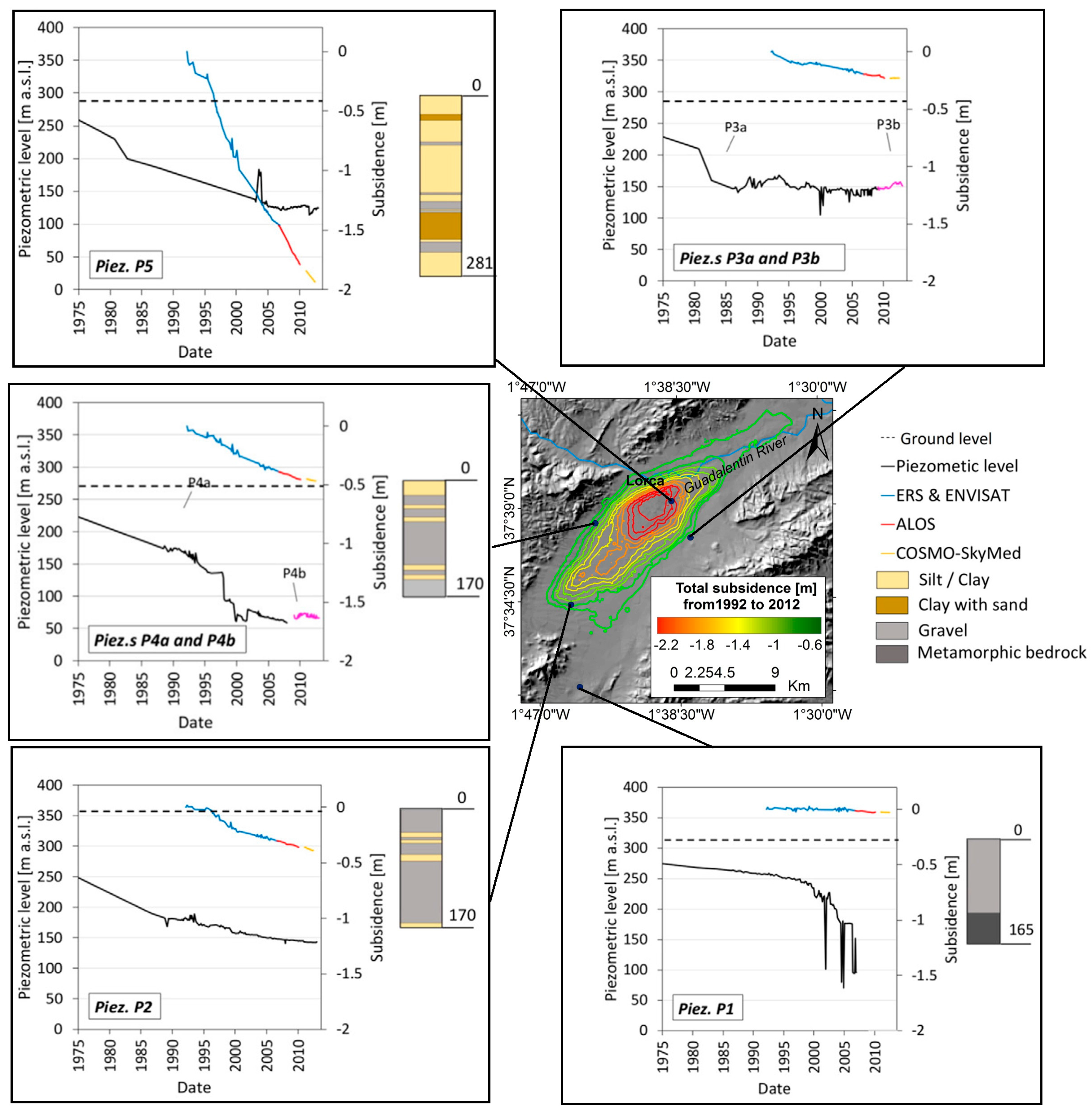
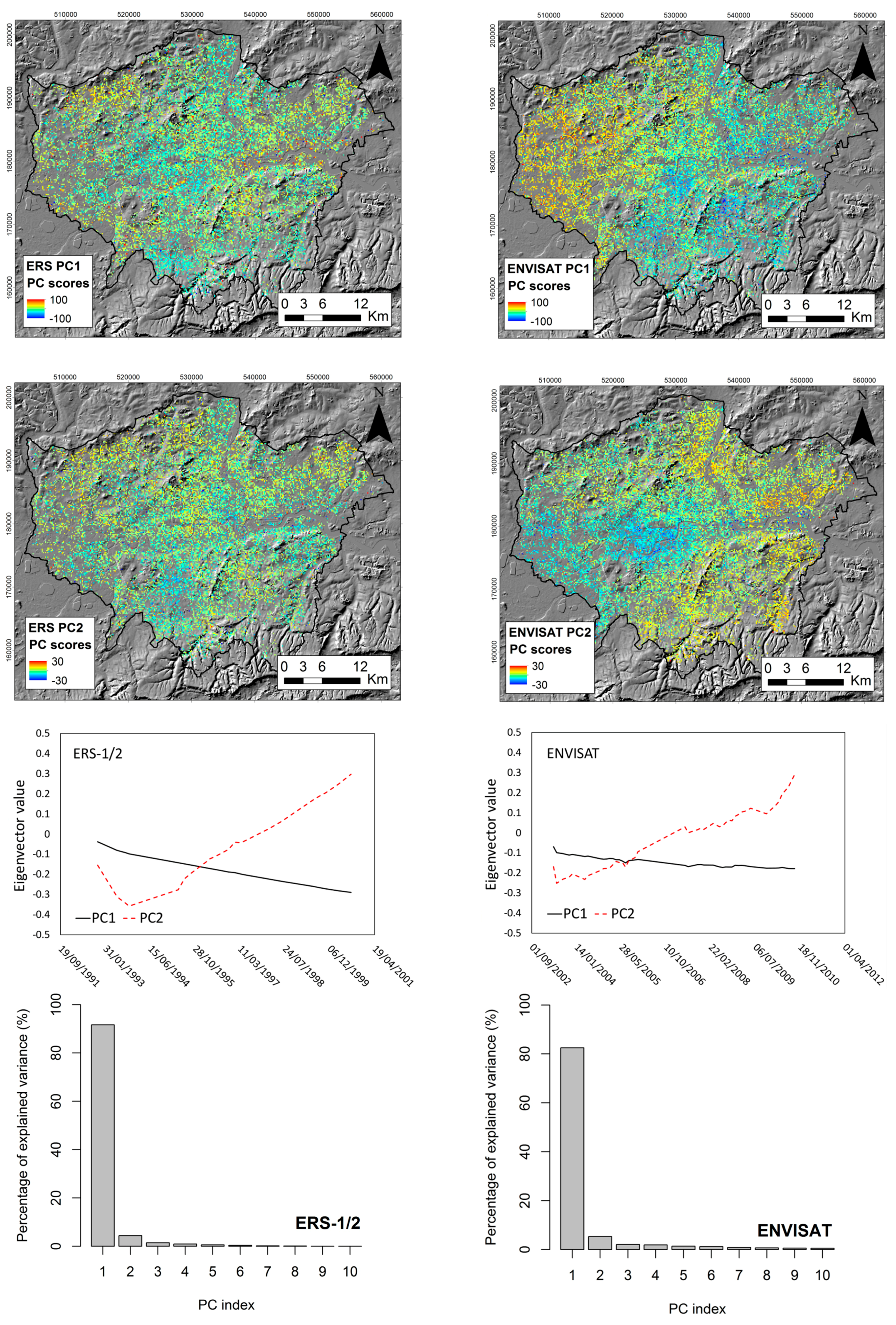

| Test Case | SAR Data | Sensor | Processing Technique | Time Span | Type of Land Subsidence | Area (km2) |
|---|---|---|---|---|---|---|
| Oltrepo Pavese (Italy) | ERS-1/2 | C-band | SqueeSAR™ | 1992–2000 | Natural and anthropic causes | 440 |
| RADARSAT-1 | C-band | SqueeSAR™ | 2003–2010 | |||
| Alto Guadalentín Basin (Spain) | ERS-1/2 | C-band | StaMPS | 1992–2000 | Anthropogenic subsidence due to groundwater extraction | 277 |
| ENVISAT | C-band | StaMPS | 2003–2007 | |||
| ALOS-PALSAR | L-band | SPN | 2007–2010 | |||
| COSMO-SkyMed | X-band | SPN | 2011–2012 | |||
| London Basin (United Kingdom) | ERS-1/2 | C-band | IPTA | 1992–2000 | Natural and anthropic causes | |
| ENVISAT | C-band | IPTA | 2002–2010 | 1360 |
© 2017 by the authors. Licensee MDPI, Basel, Switzerland. This article is an open access article distributed under the terms and conditions of the Creative Commons Attribution (CC BY) license (http://creativecommons.org/licenses/by/4.0/).
Share and Cite
Bonì, R.; Meisina, C.; Cigna, F.; Herrera, G.; Notti, D.; Bricker, S.; McCormack, H.; Tomás, R.; Béjar-Pizarro, M.; Mulas, J.; et al. Exploitation of Satellite A-DInSAR Time Series for Detection, Characterization and Modelling of Land Subsidence. Geosciences 2017, 7, 25. https://doi.org/10.3390/geosciences7020025
Bonì R, Meisina C, Cigna F, Herrera G, Notti D, Bricker S, McCormack H, Tomás R, Béjar-Pizarro M, Mulas J, et al. Exploitation of Satellite A-DInSAR Time Series for Detection, Characterization and Modelling of Land Subsidence. Geosciences. 2017; 7(2):25. https://doi.org/10.3390/geosciences7020025
Chicago/Turabian StyleBonì, Roberta, Claudia Meisina, Francesca Cigna, Gerardo Herrera, Davide Notti, Stephanie Bricker, Harry McCormack, Roberto Tomás, Marta Béjar-Pizarro, Joaquín Mulas, and et al. 2017. "Exploitation of Satellite A-DInSAR Time Series for Detection, Characterization and Modelling of Land Subsidence" Geosciences 7, no. 2: 25. https://doi.org/10.3390/geosciences7020025
APA StyleBonì, R., Meisina, C., Cigna, F., Herrera, G., Notti, D., Bricker, S., McCormack, H., Tomás, R., Béjar-Pizarro, M., Mulas, J., & Ezquerro, P. (2017). Exploitation of Satellite A-DInSAR Time Series for Detection, Characterization and Modelling of Land Subsidence. Geosciences, 7(2), 25. https://doi.org/10.3390/geosciences7020025











